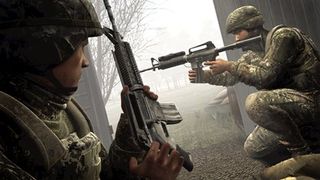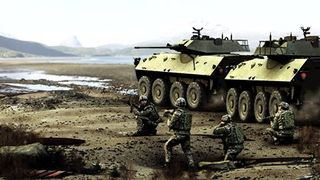Operation Flashpoint 2: Dragon Rising
There are always casualties in war. In this case, authenticity is definitely not one of them
Imagine if you were playing a war game and you suddenly noticed that the weapon you were wielding was held together by eight-sided nuts instead of the statutory six-siders. You’d naturally be horrified, the integrity of the experience would be compromised, and you’d probably never touch it again. Thankfully, that actual problem has already been rectified, and the person responsible presumably sent to Codemasters’ version of Guantanamo Bay. That said, the bloke who spotted this heinous error does admit to occasionally questioning his own sanity. A lovely story, we’re sure you’ll agree, and a pertinent example of the painstaking attention to detail going into Operation Flashpoint 2: Dragon Rising, which is already threatening to be the most authentic military simulator ever made. Or at least since the groundbreaking original game, which is now a ripe seven years old; a lifetime in game development, and indeed modern warfare.

As brand manager Andrew Wafer explains, “We took the concept of what Flashpoint was, the first game, and we really tried to refine that and build upon that in terms of the scope that we wanted to do. That comes down to not just the authenticity of things – like how the modern military works – but things like the size of the environments, the power of the weaponry, elements like multiplayer and the command structure and tactical maneuvers. It’s about being able to move around in these big environments, make your own tactical decisions and orders, and utilize a vast array of realistic vehicles and weapons to do that. It’s about big battles; it’s about big military warfare. It’s not small skirmishes with a couple of troops; it’s about fighting forces which are equally matched, big global superpower armies.”
To recap, those superpowers are the good old US of A in the form of the US Marines Corps (with the correct demographic breakdown, naturally) and the Chinese, in the form of the People’s Liberation Army. The realistic scenario sees the two sides scuffling over the rights to an oil-rich island off the coast of Russia, north of Japan, with America sticking up for the Ruskies. Based on an actual location, the island is known in the game as Skira, although the topology and geology has been lifted – thanks to Google Earth – from a real-life island in Alaska. Not content with pilfering an entire island, Codemasters have engineered an erosion system and a water system, with functioning oceans, lakes and rivers. There’s also a bloke whose sole job seems to be building trees, piecing them together branch-by-branch, replete with a detailed damage model. Throw in a bit of weather and a day/night cycle and you’re left with 220 square km of living, breathing landscape.

To put that into context, it’ll take the best part of three and a half hours to drive from one end to the other, or 20 minutes to fly. And while what you see inthe imagesare “visual targets” as opposed to actual screenshots, the whole thing is being put together using Codemasters’ Neon/EGO engine, as used in the visually resplendent Colin McRae: Dirt and more recently, GRID.
Oct 10, 2008
Sign up to the 12DOVE Newsletter
Weekly digests, tales from the communities you love, and more
Most Popular
